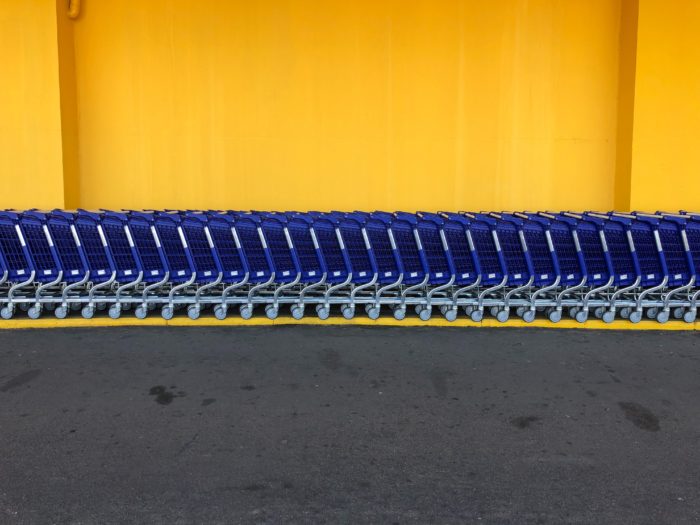What do your shoppers want out of the buying process? For many, the answer is instant gratification. It’s easy product comparisons and competitive prices: an experience. And, it’s this desire for a holistic shopping experience that is invigorating much of the industry, led in part by digital-first brands.
After cutting their teeth in eCommerce, these brands are moving in-store and further disrupting brick-and-mortar retail. They’re seizing an opportunity to grow by going omni and bringing their once-online business models across channels.
Here’s why.
In-Store Is Alive and Well
“Brick-and-mortar retail is dead.” “Online shopping has killed brick-and-mortar retailers.” Remember headlines like that? They were everywhere a few years ago. Well, how’s the death of in-store retail been going?
The answer: Not well. Brick-and-mortar retail is still alive and thriving. According to PwC’s Global Consumer Insights Survey 2018, 44 percent of consumers polled buy products in-store, up from 42 percent in 2013. In fact, of the four channels reflected in the survey—in-store, PC, tablet, and mobile—only PC went down in the past six years, from 27 percent to 20 percent.
Retail remains a healthy mix of channels. This fact has spurred many eCommerce brands to begin to sell in-store or open stores of their own. For example, one of the major digital-first brands to do this is Harry’s Razors.
Harry’s Razors began as a direct-to-consumer subscription service available online only. In the last few years, the shave club struck a deal with Target to sell products in-store and followed that up with another deal with Walmart. Harry’s was valued at $750 million in 2016 and raised an additional $112 million of capital in early 2018. Competitor Dollar Shave Club was acquired by Unilever for $1 billion in 2016, another sign of a strong future for shave clubs like Harry’s.
44% of consumers buy products in-store in 2018.
What’s in It for You?
Harry’s—and many other companies—has done well bringing in-store sales into the mix. Following their lead, there’s plenty to get out of an omnichannel sales strategy for other digital-first brands.
Drive Greater Sales
It’s no secret that the main motivator behind any for-profit business is, well, profit. Omnichannel sales can help with that. Looking at Harry’s beginnings, its products were initially available only on the Harry’s website. This was great for a start-up, so it could test the waters and develop a viable business model. Once that was done, more sales could be realized by expanding in-store.
The partnership with Target is one more channel for consumers to buy Harry’s products. The deal with Walmart is another, and the eCommerce side isn’t going anywhere. Business growth is a concept as old as capitalism, and it’s a key reason why digital-first brands should want to sell in-store.
Increase Brand Awareness
Another reason why brick-and-mortar is beneficial is increased brand awareness. Visibility is important, from your ability to raise capital to attracting new customers. An in-store display helps with that, as features such as placement on shelf and end caps can draw in passers-by. You can introduce your brand to a set of shoppers who otherwise wouldn’t find you online.
The in-store experience is also great for getting creative and having a bit of fun. You can connect directly with consumers and show, not just tell, how your brand is valuable. This can drive more awareness to your brand via word-of-mouth or media attention.

Encourage More Upsells
Brick-and-mortar retail is also great for encouraging more upsells. Given that in-store displays carry more than one product, shoppers get to see your full assortment in front of them. This real-world “Customers who bought this item also bought … ” tactic works well to inspire additional purchases.
Brick-and-mortar retail that succeeds today does so in part because of that in-store experience crafted by displays, store associates, and instant gratification. Upsells are associated with that. Shoppers enter the store for one product and end up leaving with others due to attractive displays or knowledgeable associates.
This part of retail is different in-store compared to online, obviously, making an omnichannel approach more comprehensive.
Remain Competitive
What’s the competition doing? This question motivates plenty of high-level decisions in all businesses, including retail. Therefore, more digital-first brands are going in-store as well.
We’ve already mentioned Harry’s, but they’re not alone. Brands like Casper, Honest, Bonobos moved in-store. Major players in eCommerce like Amazon and Wayfair are also opening brick-and-mortar hubs. You can find a digital-first brand in most industries with in-store aspirations.
The result is more companies opening physical locations or partnering with brick-and-mortar retailers. It’s a major trend, and staying competitive is a strong motivator.
In-store excels when shoppers get an experience, not just a product.
Want to Sell In-Store?
Do any of these reasons resonate with your brand? Or, perhaps you’ve already started to sell in-store and are looking to continue that growth.
If so, make sure the in-store side of your business is operating smoothly. Elements such as merchandising compliance, store associate knowledge, and overall shelf health are crucial to increased sales. Connect with Wiser today for:
- Pricing and merchandising compliance across your reseller network
- In-store market intelligence from our network of mystery shoppers.
- Privately crowdsourced in-store data collection
- And more!
Best of luck achieving your multi-channel goals!














